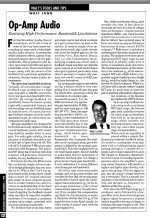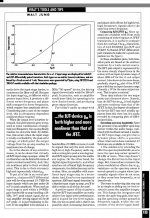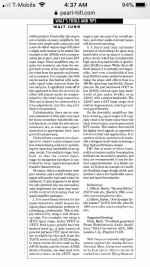Two problems with opamps:
1. they are cheapish
2. they are designed by engineers using science, and are therefore part of the anti-music conspiracy which brought valves, LP, semiconductors, FM, CD and digital sound into being
On these grounds alone, they should be avoided by all genuine music-lovers.
Don`t forget the "unnatural" 440 hz concert pitch (256 hz C is natural)
and the "unnatural" 12-tone square root 2 based scale as opposed to the pi-derived natural musical scale.
Which both should also be "avoided by all genuine music-lovers".
The only problem with OP-AMPS is that you have to examine very carefully the fine print for their true specs, to avoid being misled by the company's promotion fanfare, like with most complicated devices.
Distortion for example, might be announced as being extraordinary, but it might not even be suitable for your little application because it skyrockets at 20khz, or at an output voltage higher than 3Vrms, or at a load lower than 4KΩ, etc.
Let alone that most specs are to be taken with a grain of salt, as they are usually overoptimistic, hid by a "typical" value which at best is true under unusual conditions. Or worse -as it happens often, those revealing data might be omitted altogether.
All of this is due to the companies fighting each other for a bigger segment of the market (for profit). I always appreciate the most honest ones, and those who bother to offer the most detailed data/models.
Of course, I wouldn't compare OP-AMPS with tubes, as I wouldn't compare the Nissan Leaf EV with a horse.
Distortion for example, might be announced as being extraordinary, but it might not even be suitable for your little application because it skyrockets at 20khz, or at an output voltage higher than 3Vrms, or at a load lower than 4KΩ, etc.
Let alone that most specs are to be taken with a grain of salt, as they are usually overoptimistic, hid by a "typical" value which at best is true under unusual conditions. Or worse -as it happens often, those revealing data might be omitted altogether.
All of this is due to the companies fighting each other for a bigger segment of the market (for profit). I always appreciate the most honest ones, and those who bother to offer the most detailed data/models.
Of course, I wouldn't compare OP-AMPS with tubes, as I wouldn't compare the Nissan Leaf EV with a horse.
Of course, I wouldn't compare OP-AMPS with tubes, as I wouldn't compare the Nissan Leaf EV with a horse.
LOL!
Nice one.
Hello,
Would argue it is how an engineer uses the parts that matters most. Discrete or op-amps, it matters how the circuit loads, powers and deals with known limits of the parts. Can make either sound quite bad, or quite good.
Regards,
Greg

I believe in the saying: "The more panes of glass,the more distorted the view",
It rather depends on the panes, doesn't it? My little 35mm Nikon lens has 8 pieces of glass in 6 groups, and is one of the sharpest, least distorted arrangements of glass that you can look through. You can get lenses with the same focal length and ratio, with fewer elements, which are not as sharp.
I think the analogy holds in audio. My preamp has just 2 FETs per channel, and I like that, but I also recognize that circuits with more active elements can have lower distortion (just not enough to matter to me).
How is this different from analyzing and taking care of of the parasitic capacitances in discrete parts, circuits and assemblies?
Jan
Whenever something is marketed, the product is a solution for someone.
In the case of op-amps, where is the problem? and whose problem is solved.
As I said they are the correct part for some products.
Discrete consumer circuits simply allow to much lattitude during the product life cycle. So discrete designs are ‘discouraged’.
FPGA,SOC,MEMORY etc : how many engineers must pause a current project in order to assist with ‘end of life’ redesigns? So the question should always be, is the component a solution for the product or solving ‘someone elses problem’ ie bonus, stock options etc?
I still use TI,ADI,On-semi and Microchip high volume parts because I’ve never been burned by those companies.
But jellybean discrete is still first choice.
ROFL!2. they are designed by engineers using science, and are therefore part of the anti-music conspiracy which brought valves, LP, semiconductors, FM, CD and digital sound into being
On these grounds alone, they should be avoided by all genuine music-lovers.



-Gnobuddy
From discrete vs IC:
Not possible to fix compensate/internal parasitics on encapsulated IC.
Only what is on pins.
There's no "fixing" to do, they are just there usually far smaller than any discrete. This is just fantacising.
One thing I have found with op amps is they have a " less than sweet spot ". That is a gain range that might sound strangely different. Take the MC33078. At unity gain it sounds excellent and possibly better than a piece of wire as it has more drive current. It can sound remarkably like no op amp at all. Not bad for a super cheap type. At a gain of two it no longer sounds the same. Like your favourite wine from a bad year. As the gain hits 10 it's almost like it's been decanted. OK it sounds more rounded than the unity gain. For all that it did the job and if anything became warmer. Kodak could always sell a film that made the red stronger. Even professionals bought the red version.
I don't really give a damn if anyone wants to believe that idea. I think it is a handy tip for someone who has issues of the head and the heart over these things. To my mind none of this is hard to understand technically. I dare say a gain of two inverting if a double inverting stage might be better. All I say is be aware it can happen.
I once said we should set a competion where only NE5532/4 2N3055/2955 BC327/337 BD139/140 could be used. I feel if you have good ears you could make something with these to put most things to shame. It wouldn't be easy. I would use Quad ESL63's speakers to judge the results and maybe KEF LS50's. Turntable Lenco GL75 with SME M2 Denon DL110 ( it's a tricky one ). CD player, whatever sounds OK ( Old Quad 67 with Crystal DAC sounds good ). I think most people would use NE5534 as it can be tweaked, it can even have external transistors added via comp pins. TIP or 2N devices. MJ 15015 seem to be marked up as 2N3055 by ON. That's fine. 3055E/H. Some would use the NE5532 and 2N3055 to make a voltage regulator. You can have red LED's and 1N4007/1N4148.
I don't really give a damn if anyone wants to believe that idea. I think it is a handy tip for someone who has issues of the head and the heart over these things. To my mind none of this is hard to understand technically. I dare say a gain of two inverting if a double inverting stage might be better. All I say is be aware it can happen.
I once said we should set a competion where only NE5532/4 2N3055/2955 BC327/337 BD139/140 could be used. I feel if you have good ears you could make something with these to put most things to shame. It wouldn't be easy. I would use Quad ESL63's speakers to judge the results and maybe KEF LS50's. Turntable Lenco GL75 with SME M2 Denon DL110 ( it's a tricky one ). CD player, whatever sounds OK ( Old Quad 67 with Crystal DAC sounds good ). I think most people would use NE5534 as it can be tweaked, it can even have external transistors added via comp pins. TIP or 2N devices. MJ 15015 seem to be marked up as 2N3055 by ON. That's fine. 3055E/H. Some would use the NE5532 and 2N3055 to make a voltage regulator. You can have red LED's and 1N4007/1N4148.
Not to continue this death by a thousand cuts but Walt Jung’s findings are interesting for modern designs.
I did a search in this thread for ‘Jung’ and a few mentions turned up so I’m adding pics of his article.
My current diy project is a feed forward compressor. Its working great with the Butler AD275 front end but I’m exploring a discrete version now.
here is Jung’s article.
-
I did a search in this thread for ‘Jung’ and a few mentions turned up so I’m adding pics of his article.
My current diy project is a feed forward compressor. Its working great with the Butler AD275 front end but I’m exploring a discrete version now.
here is Jung’s article.
-
Attachments
....Take the MC33078. At unity gain it sounds excellent and possibly better than a piece of wire....I don't really give a damn if anyone wants to believe that idea.
So you tried it then? I suspect when op amps get to be this good if fake numbers where put on them most would hear what the numbers made them think. Placebo. The point to know is the exact op amp is not the question, it's knowing how to get the best of any. SSL used NE5534 and NE5532. Sometimes 90 end to end. As Dave Mate said " didn't sound too bad considering ". Many LP's were made using SSL desks. The LP's people use to judge this or that op amp. I am having a drink with John Deans ex of SSL tonight. I will ask what his best thoughts on this are. I know Dave did some work very late in the day to get rid of 5534's at SSL, I suspect OPA604 or whatever. Their main problems were PSU's.
When I can I go to concerts. It's the world of 78's with more dynamic range. Most recorded music is like baby food. Beethoven is 78's and Poulenc like LP's. Never heard a sound like CD's thinking about it. This must be that the good recording engineers are dead and replaced by people with PHD in soldering. Many CD's that were carefully transcribed from analogue sound very OK. I think analogue mastering suits better. A mistake in levels is mostly like a photo where without reference to a better version can seem OK.
I asked John ex of SSL. As far as he knows the SSL updates never happened even if experiments were done. That is interesting at the desks were the price of a central London house. Modular so easy to update. What the SSL team did know was how to get a more direct route through the desk for their home recordings. They would show anyone interested. SSL made their money by getting music made quickly. Many would accept a slight reduction in musicallity for reduced studio costs. TV adverts being prime customers. Pro Tools killed it.
I asked John ex of SSL. As far as he knows the SSL updates never happened even if experiments were done. That is interesting at the desks were the price of a central London house. Modular so easy to update. What the SSL team did know was how to get a more direct route through the desk for their home recordings. They would show anyone interested. SSL made their money by getting music made quickly. Many would accept a slight reduction in musicallity for reduced studio costs. TV adverts being prime customers. Pro Tools killed it.
Given the choice most recording engineers I've met back in the analogue days would have recorded through a Trident and then mixed on an SSL.
SSLs had more flexible routing, an incredible stereo buss compressor besides excellent compressors on every channel and imparted less of its own sound than a Trident.
Tridents were euphonic but it could get too much if you ran a track through it a few times as you would when recording and mixing on the same console.
SSLs had more flexible routing, an incredible stereo buss compressor besides excellent compressors on every channel and imparted less of its own sound than a Trident.
Tridents were euphonic but it could get too much if you ran a track through it a few times as you would when recording and mixing on the same console.
- Status
- This old topic is closed. If you want to reopen this topic, contact a moderator using the "Report Post" button.
- Home
- General Interest
- Everything Else
- What is wrong with op-amps?


